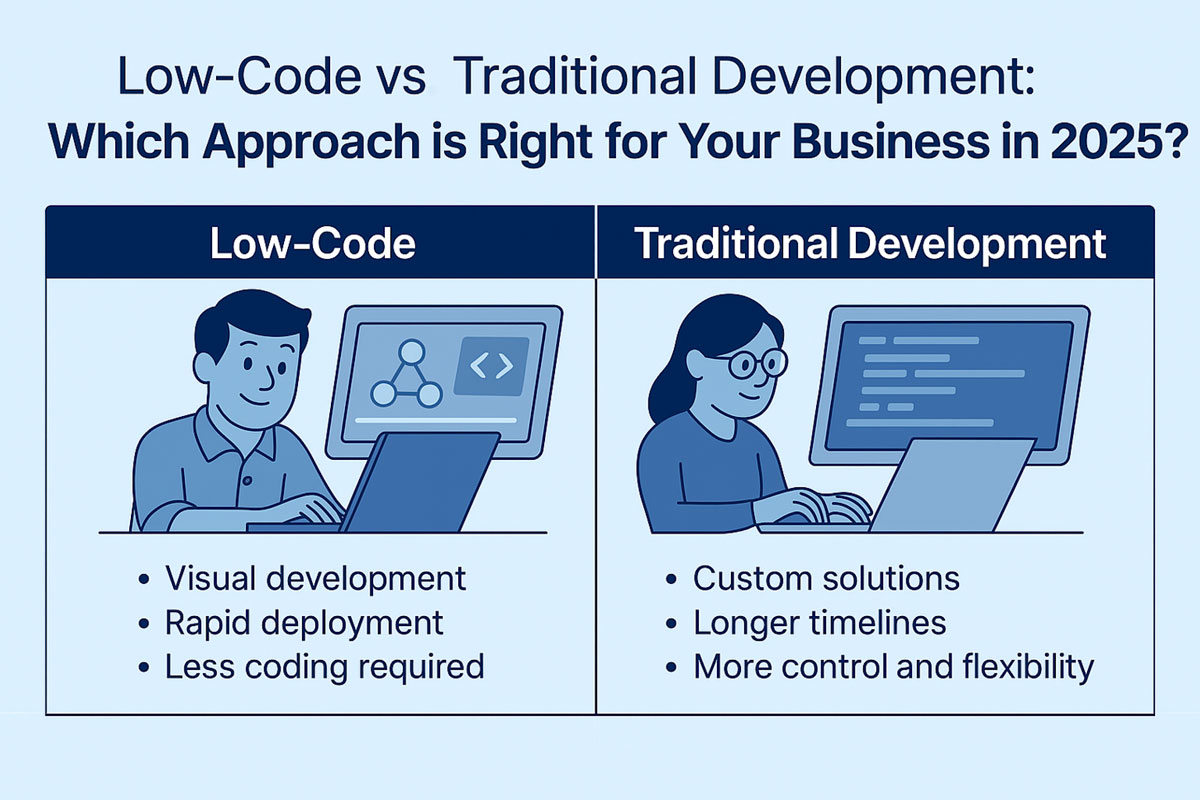
21 July 2025 | Admin
As we navigate through the digital transformation era in 2025, businesses are constantly looking for ways to accelerate development, reduce costs, and stay competitive. A key decision in this journey is choosing the right development approach: low-code vs. traditional development. Each comes with its own strengths, trade-offs, and ideal use cases. Whether you’re a CTO, startup founder, or a non-technical entrepreneur, understanding these differences is crucial.
What is Low-Code Development?
-
Low-code development refers to a visual software development approach that requires minimal hand-coding. It enables users to build applications through drag-and-drop interfaces, pre-built templates, and visual workflows. Originating from the need to accelerate digital innovation, low-code platforms like Microsoft Power Apps, Kissflow, and Outsystems are now widely adopted across industries.
Key Features:
-
1. Visual development interfaces.
-
2. Rapid deployment
-
3. Minimal coding for functionality
-
4. Ideal for citizen developers and quick MVPs
What is Traditional Software Development?
Traditional development involves building software using full-scale programming languages such as Java, Python, PHP, or .NET. This approach gives developers full control over the software architecture, integrations, and UI/UX but requires technical expertise and longer timelines.
Key Characteristics:
-
1. Custom coding from scratch
-
2. High flexibility and control
-
3. Skilled development teams required
-
4. Extended development life cycles
| Aspect | Low-Code Development | Traditional Development |
|---|---|---|
| Speed | Faster time-to-market | Slower due to coding from scratch |
| Customization | Limited customization | Highly customizable |
| Skill Requirement | Minimal (citizen developers) | High (experienced developers) |
| Cost | Lower initial costs | Higher upfront investment |
| Control & Scalability | Limited for complex systems | Full control and high scalability |
| Integration Flexibility | Relies on connectors/APIs | Full custom integration possible |
-
1. Faster Time-to-Market: Build and deploy apps in weeks, not months.
-
2. Cost Efficiency: Save on developer hours and resources.
-
3. Easy Prototyping: Quickly test ideas and iterate based on user feedback.
-
4. Empowers Non-Tech Users: Business users can contribute to development.
-
5. Cloud Integration: Seamlessly connect with SaaS platforms and tools.
-
6. Built-in Security: Many platforms come with compliance features (GDPR, HIPAA).
Integrating Low-Code Tools into Existing IT Infrastructure
Modern low-code platforms are built to integrate with enterprise systems such as CRMs, ERPs, and databases using APIs and pre-built connectors.
Examples:
-
1. Power Apps + SharePoint + Microsoft 365
-
2. Kissflow + GSuite + Slack
Considerations:
-
1. Data Governance: Ensure proper access controls and compliance.
-
2. Training Needs: Upskill employees to use low-code tools effectively.
-
3. IT Oversight: Maintain oversight on shadow IT and security protocols.
Future Trends in Low-Code Application Development
-
1. AI-Assisted App Building: AI will help automate workflows and suggest logic flows.
-
2. Enterprise-Level Adoption: Larger companies are now using low-code for mission-critical apps.
-
3. DevOps + Low-Code: Integrating CI/CD pipelines and version control.
-
4. Fusion Teams: Collaborative development between IT and business.
-
5. From MVPs to Production Apps: Shift from just prototyping to running full business operations.
Low-Code vs Traditional: Which Businesses Should Choose What?
Low-Code is Ideal For:
-
SMEs and startups needing quick MVPs
-
Internal apps (HR, CRM, project tracking)
-
Teams with limited developer resources
-
Projects requiring fast deployment and lower budgets
Traditional Development is Ideal For:
-
Enterprise-grade applications with complex requirements
-
Industries like finance, healthcare, or manufacturing
-
Projects needing complete control over data, UI, and architecture
-
Apps requiring unique integrations or processing logic
In our opinion choosing the right path for digital transformation
Both low-code and traditional development have their place in the digital landscape of 2025. Low-code empowers speed, agility, and accessibility ideal for rapidly evolving businesses. Traditional development, on the other hand, delivers unmatched flexibility and control for complex or large-scale applications.

